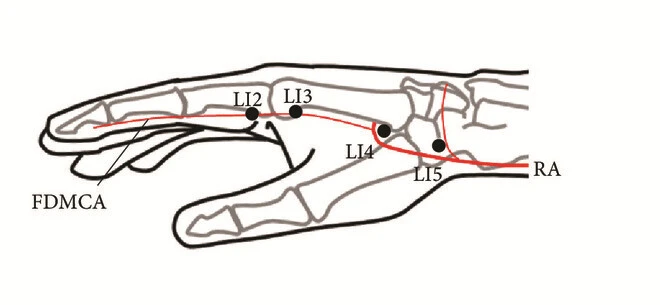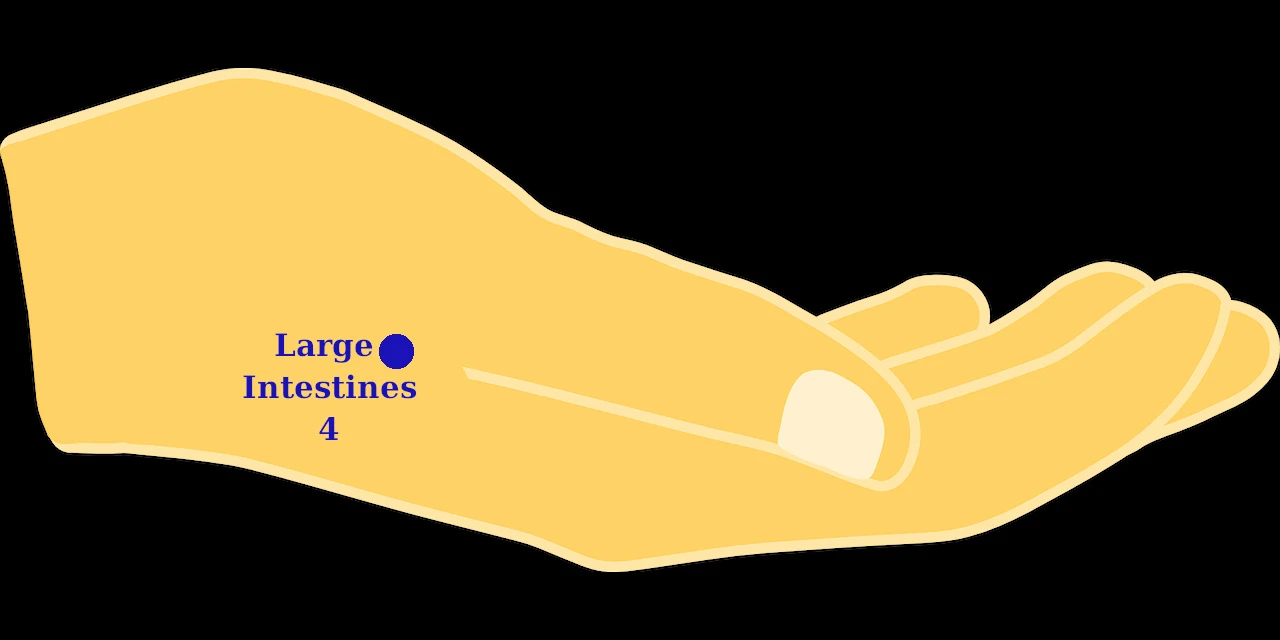This post may contain affiliate links and ads in which we may earn a small percentage of purchases.
Large Intestines 4, also known as LI4, LI-4, or LI 4 (“Hegu” in TCM, gō koku in Korean Acupuncture) is one of the most well-known and widely used acupuncture points. As soon as you point to the area between the thumb and index finger, most people recognize it. It’s that point people instinctively press when they’re feeling a headache coming on or some tension in their hands.

Professional-grade Korean cupping set with 17 durable cups and extension tube for muscle therapy.
View Cupping Set
A clear and beginner-friendly guide covering over 400 acupuncture points, ideal for students and learners.

Portable dual-channel TENS/EMS device with 24 therapy modes for targeted muscle and pain relief.
View DeviceTable of Contents
This point is incredibly versatile, providing benefits from pain relief to overall relaxation. It’s commonly used to treat issues ranging from the head and neck to areas all the way down to the feet. Whether it’s tension in the upper body, headaches, or even digestive issues, LI4 is often part of the solution.
Location of Large Intestine 4
Large Intestine 4 is located between the first and second metacarpal bones, specifically distal to the first metacarpophalangeal joint. At the midpoint of the second metacarpal bone and close to its radial border1. I have to give credit to my mentor, Dr. San Huang, the late head of our clinic, for teaching us a unique and, in my opinion, definitive method of locating this point.

A stainless-steel acupuncture pen and gua sha set for massage, reflexology, and tension relief.
View ProductTo find LI4, have the patient close their thumb and index finger together. You’ll see a noticeable crease between the two metacarpal bones. LI4 is found just proximal to this fold, roughly about a quarter of a centimeter from the crease. This technique ensures precise point location, which I believe is key to effective treatment.

The point can be needled to a depth of up to one cun. In my practice, the depth and angle of needling depend on the patient’s position. For instance, if the patient is lying face down, adjusting their arm position is necessary to ensure easy access to the point and proper needle insertion.

Research has shown that LI4 is significantly closer to the vascular branches reaching the radial artery than other points on the large intestine meridian.2
Functions of LI4
Clinically, Large Intestines 4 is used in conditions such as headaches, sore throats, hand pains, and infection or inflammation in the facial area.3
Functions According To TCM
Foundations of Chinese Medicine (Maciocia)4
Expels exterior wind
Removes obstructions from the channel
Promotes labor
Bio-med Functions
- Pain management
- Headache
- Sore Throat
- Inflammation
- Dysfunctions of the mouth
- Myofascial temporomandibular disorders
- Bell’s Palsy
Acupressure and Large Intestine 4
Applying acupressure to LI4 is a simple yet powerful technique that can be practiced by anyone, anywhere.
One of the best aspects of using LI4 acupressure is its versatility. I use it constantly—whether I’m in a meeting, listening actively, or dealing with stress. Pressing this point helps me stay present and focused, preventing my mind from drifting off. Additionally, LI4 can be beneficial for alleviating various physical symptoms, such as headaches, pain, digestive issues like bloating, and abdominal distension. As part of the Large Intestine Meridian (Hand Yangming), this point is incredibly universal and effective for achieving a wide range of therapeutic results.
How To Apply Acupressure To LI4
To apply acupressure on yourself, press the point firmly for about three seconds and then release. I often use a sequence of six to eight medium-pressure squeezes rather than continuous pressure. This approach allows for quick relaxation of the muscle and provides a rhythmic stimulation, which helps to clear the mind and relieve stress.
LI4 is one of those “Power Points”—points that have a noticeable, immediate impact. This point is particularly effective for relieving areas of muscle tension, such as the forearms, shin muscles (tibialis anterior), and other lower extremity muscles. Its effectiveness can be observed across many patients, making it a reliable and easily teachable point for acupressure. Patients can use this point independently whenever they are stressed, and its effects are often immediate and measurable.
The versatility and effectiveness of LI4 make it one of the most valuable acupressure points, both for practitioners and patients alike.
Moxibustion and LI4
Moxibustion involves the use of burning mugwort (moxa) to apply heat to an acupuncture point, enhancing its therapeutic effects.
When applying moxibustion to LI4, you have a couple of different options. You can apply the moxa directly to the needle, which allows the heat to penetrate deeply into the point, or you can hover the moxa stick over the point without contact. Both methods provide warmth and stimulation that can improve circulation, relax muscles, and further enhance the benefits of treating LI4.
Research on LI4
There is a vast amount of research on Large Intestine 4, enough to begin to understand what may be some of the most beneficial uses of this acupuncture point. Let’s look at some of the studies available.
Anatomy of Human Body and Large Intestine 4 Acupoint
Research on Large Intestine 4 spans across multiple areas of interest. One study published in a 2019 journal of Evidence Based Complementary and Alternative Medicine revealed a link to LI4 and “increased blood flow in the skin, making it useful in treating peripheral circulatory issues such as Raynaud’s disease.”5
The study also confirmed that LI4 may lead to the dilation of local blood vessels, likely due to the release of neuropeptides such as Substance P (SP) and calcitonin gene-related peptide (CGRP), which both contribute to vasodilation and increased blood flow.
The closeness of Large Intestine 4 to the radial artery’s vascular branches explains why this point is often so effective in promoting increased blood flow and provides a physiological basis for its use.
Myofascial Temporomandibular Disorders
A case study published in a 2022 issue of Medicine examined a 29-year-old patient having pain with mastication (chewing) getting worse over a course of a month. Patient was administered acupuncture for 30 minutes bilaterally (both sides) and patient reported improvement on all measurable metrics after followup 4 days later.
LI4 and Alzheimer’s Research
This study published in a 2014 journal of the “American Journal of Alzheimer’s Disease & Other Dementias” looked at how acupuncture could possibly help people with Alzheimer’s disease. Researchers focused on two acupuncture points, Liver 3 (Lv3) and Large Intestine 4 to see if they could improve brain function. They found that stimulating these points improved connections in parts of the brain that help with memory and thinking, especially in areas that are usually affected by Alzheimer’s.6
Specifically, the study found increased activity in:
- Right Inferior Parietal Lobule (IPL): This region is associated with spatial attention.
- Right Middle Temporal Gyrus (MTG): This area plays a role in providing information and is related to memory functions.
- Left Posterior Cingulate Cortex (PCC): This is a key hub in the brain for integrating information and regulating the balance between internal and external cognition.
The study also suggested that patients with less severe symptoms might respond better to acupuncture treatment. Authors suggest that acupuncture might be helpful for people in the early stages of the disease, making it easier for their brains to work better. It could be a safe, non-invasive way to support memory and reduce symptoms of Alzheimer’s.
Contraindications of LI 4
This point is contraindicated during gestation.
This information is for educational purposes only. Please consult with a healthcare provider for any diagnosis or treatment.
- Wang, Fang-Li BMa; Chu, Jia-Mei MD, PhDa; Yu, Jing MMa,*; Wang, Qin BMa. Acupuncture at Hegu point (LI4) for myofascial temporomandibular disorders: A case report. Medicine: Case Reports and Study Protocols 3(12):p e0263, December 2022. | DOI: 10.1097/MD9.0000000000000263 ↩︎
- Umemoto K, Naito M, Tano K, et al. Acupuncture Point “Hegu” (LI4) Is Close to the Vascular Branch from the Superficial Branch of the Radial Nerve. Evid Based Complement Alternat Med. 2019;2019:6879076. Published 2019 Jun 25. doi:10.1155/2019/6879076 ↩︎
- Casey, G. P. (2022). Anatomical characterization of acupoint large intestine 4. The Anatomical Record, 305(1), 144–155. https://doi.org/10.1002/ar.24681 ↩︎
- Maciocia G. The Foundations of Chinese Medicine. 2nd ed. Churchill Livingstone; 2005:909-910. ↩︎
- Umemoto K, Naito M, Tano K, et al. Acupuncture Point “Hegu” (LI4) Is Close to the Vascular Branch from the Superficial Branch of the Radial Nerve. Evid Based Complement Alternat Med. 2019;2019:6879076. Published 2019 Jun 25. doi:10.1155/2019/6879076 ↩︎
- Liang P, Wang Z, Qian T, Li K. Acupuncture stimulation of Taichong (Liv3) and Hegu (LI4) modulates the default mode network activity in Alzheimer’s disease. Am J Alzheimers Dis Other Demen. 2014;29(8):739-748. ↩︎
Medical Disclaimer: This article is for informational and educational purposes only and is not a substitute for professional medical advice, diagnosis, or treatment. Always consult a qualified healthcare provider with any questions about a medical condition or treatment.


 Optimizing Humans Since 2004 Shop Now!
Optimizing Humans Since 2004 Shop Now!

